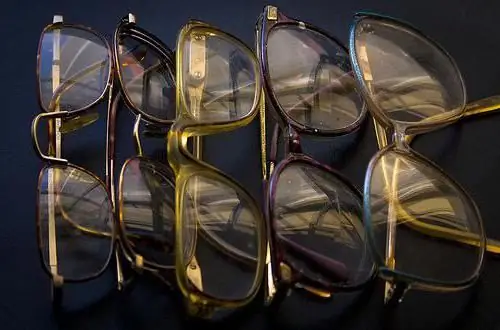2025 Author: Priscilla Miln | [email protected]. Last modified: 2025-01-22 17:55:13
The first prototypes of modern swimming goggles were invented in the 14th century in Persia. People used polished tortoise shells as lenses. In the 1930s, aviator goggles were adapted for diving with ordinary putty. In this way they were made waterproof.
Swimming goggles

Glasses designed for swimmers were first made in the 1950s. They are two lenses that are connected at the bridge of the nose. The device was fixed with suction cups. It was fastened to the head with a rubber strap. Between the lenses there is an air layer for better visibility in the water. The lenses were made of glass and were easily broken. Athletes were prohibited from using unsafe goggles during the competition. The pool goggles cut into the skin of the swimmer's eyes and flew off during the dive. Swimmers could only use them in training.
In 1976, manufacturers managed to eliminate the shortcomings of glass models. Swimming glasses were first allowed to be used by athletes at the Summer Olympics in Montreal, Canada. The most popular modelsamong athletes are considered "Swedes". This model was produced by the Swedish company Malmsten. The company was founded by the famous trainer Tommy Malmsten. He designed new glasses for the future Olympic champion Ann Sophie-Roos. She suffered from skin allergies after wearing regular swimming goggles. Tommy solved the problem. He created a new model of swimming goggles without a seal around the lenses. He assembled the first model of glasses in his own kitchen. These glasses are sold unassembled. The swimmer can assemble the glasses on his own, adjusting to the individual features of the face. This model is produced by most modern manufacturers.
Types of goggles for swimming

Distinguish between training and starting models of glasses. Starter models are rigid and streamlined. Training softer. When worn for a long time, hard-shell glasses leave red marks around the eyes. Modern models use soft silicone that does not cause skin irritation. Lenses are made from various polymers (polycarbonate).
For people with low vision, there are models of swimming goggles with diopters. Some manufacturers offer convenient accessories with removable lenses. You can swim in the pool with contact lenses. And in this case, swimming goggles will be needed to protect the eyes.
Professional athletes use models with lateral inclined elements. They make it easier to keep track of opponents swimming on adjacent lanes. Chlorination is often used to disinfect pool water. Glassesprevent eye irritation.
Reason for fogging swimming goggles

Due to the difference in temperature between the inside and outside of swimming goggles, condensation forms on them, causing them to fog up. The athlete's view is limited, and he is forced to move by touch. Divers use saliva to treat fog glasses. But this tool is ineffective and causes distortion. Treatment of glasses with toothpaste, baby shampoo and other folk remedies often leads to damage to the surface of the lenses. It is better to use a special tool to protect them - antifog.
Antifog for swimming goggles

The anti-fog agent changes the structure of the condensate and creates the thinnest film on the inner surface of the lenses. Antifog for glasses is also used as an antistatic agent. Its name is translated from English as "fog".
Fogs were first developed by NASA for transparent space suit helmets. During spacewalks, astronauts found that their helmets quickly fogged up. Since then, all helmets have undergone an "anti-fog" treatment before spacewalks.
Anti-fog products are also used for glass and plastic processing in industry. They cover the visors of motorcycle and hockey helmets. Antifog is used to combat fogging of swimming and ski goggles. It can be purchased in specialized stores. This remedychanges the tension on the surface of the water and prevents the formation of drops on the lenses. Glasses of well-known manufacturers are covered with a thin layer of antifog. To check, they are placed in the freezer for 1 minute. The protective coating usually lasts for several months, after which a new layer must be applied to the glasses.
Views

Antifog for glasses is available as a solution, spray, gel and wipes. The most convenient anti-fog products are in the form of a spray. They include: purified water, polyurethane, polyvinylpyrrolidone, decyl polyglucose, methylpyrrolidone, triethylamine. These substances create a protective film on the surface of the lenses. They are safe for the eyes.
Do not use antifog glasses that are designed for car windows. Substances that are included in their composition can cause chemical burns to the skin and eyes.
How to use eyeglass antifog
First, read the manufacturer's instructions. Glasses should be washed and degreased. For degreasing, do not use alcohol and aggressive solvents. Procedure:
- Glasses dry away from sources of heat and light.
- In a warm room, the manufacturer's recommended amount of antifog is applied to the lenses.
- Evenly distribute the product over the surface of the lenses.
- The glasses are covered with a napkin and left to dry for several hours.
- After that, they are rinsed with a jet of cold water. One layer of antifog is enough for one workout.
Glasses care forswimming
Glasses are washed in cold water with a soft cloth. Usually it is attached to the tool. In this case, do not touch the lenses with your fingers. Keep your glasses in a soft case. Do not dry them in the sun and near heaters. Do not buy cheap models of dubious production. They are often made from hazardous materials. When choosing glasses and protective equipment, you should seek the advice of a specialist.
Recommended:
Square men's glasses: types of glasses, purpose, frame material, combinations with the shape of the face and appearance with a photo

Glasses have long ceased to be a device that helps only improve vision. In addition to their direct purpose, they are used to change the image, to hide the eyes from exposure to bright sunlight or to protect against ultraviolet radiation, which a person succumbs to when working with a computer or tablet. Today we will talk about what type of appearance square men's glasses are suitable for and what types they are
Corrective glasses - what is it? Corrective glasses: general characteristics, description, varieties, photos

Visual impairment has become common today. However, there are optical devices that can solve this problem. Corrective glasses help to see how a he althy person is. What it is? These are special products used for both refraction and accommodation
Glasses for working at a computer: reviews. Glasses for a computer: the opinion of ophthalmologists

Computer glasses are an accessory that can really protect the user's eyes and prevent overexertion during prolonged work. These glasses can really protect your eyesight from monitor damage
Horn-rimmed glasses: what to wear? Is it fashionable to wear horn-rimmed glasses?

Properly selected accessories are an integral part of a fashionable look, making it more complete and harmonious. At the same time, they are able to emphasize the advantages and hide the existing shortcomings. Horn-rimmed glasses are very popular today as such an accessory. In the context of the revival of retro style, they are in special demand
How to clean glasses? Rules for the care of glasses

To prolong the life of such a beloved and sometimes necessary accessory as glasses, you need to be able to care for them and know the cleaning rules. Consider how to wipe glasses, as well as what means and ways it is better not to do this. We will also analyze the basic rules for storage and care, regardless of their purpose

